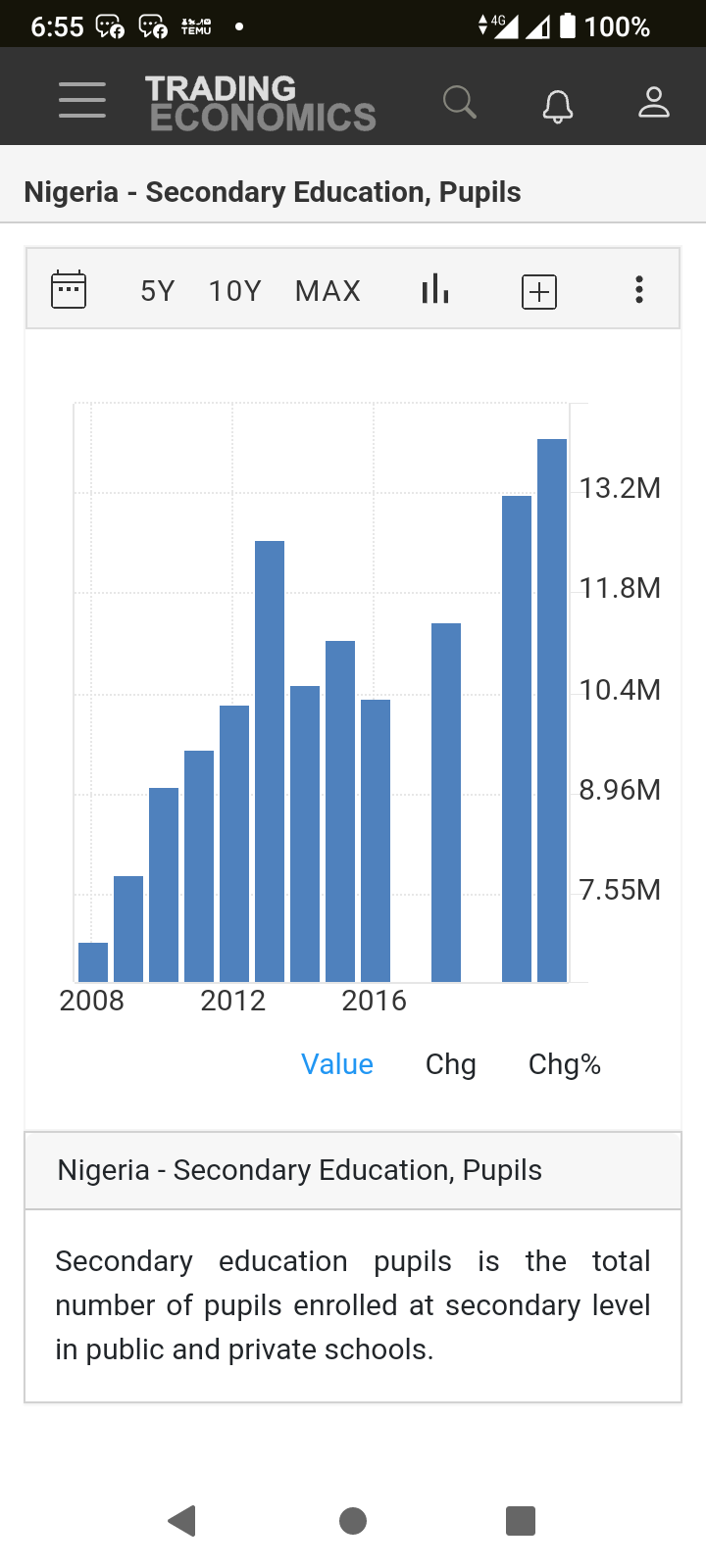In 2021, the total number of pupils enrolled in secondary education in Nigeria stood at 13,947,585, according to the World Bank’s collection of development indicators. This figure represents the total enrollment in both public and private secondary schools across the country. The data, sourced from officially recognized institutions, highlights the increasing demand for secondary education, reflecting Nigeria’s growing population and the government’s efforts to improve access to education.
Understanding Secondary Education in Nigeria
Secondary education in Nigeria is divided into two stages:
- Junior Secondary School (JSS): Covers three years (JSS 1–3) and is part of Nigeria’s Universal Basic Education (UBE) program, which aims to provide free, compulsory education up to JSS 3.
- Senior Secondary School (SSS): Also covers three years (SSS 1–3) and prepares students for tertiary education or vocational training.
For example, Lagos State, one of Nigeria’s most populous states, reported over 1.2 million students enrolled in secondary schools in 2021, reflecting both the state’s large population and its focus on education. Similarly, states like Kano and Rivers also have high enrollment figures, contributing to the national total.
Factors Influencing Enrollment
Several factors have contributed to the increase in secondary school enrollment in Nigeria:
- Government Initiatives: The Nigerian government has introduced programs such as the Universal Basic Education (UBE) scheme and school feeding programs to encourage school attendance. For instance, the UBE program has helped increase enrollment, especially in rural areas where access to education was previously limited.
- Private Sector Involvement: The rise of private secondary schools, particularly in urban areas like Abuja, Lagos, and Port Harcourt, has expanded educational options for families. For example, schools like Harryfield Montessori School in Lagos and Spring Crest Schools have become popular choices for quality education.
- Population Growth: Nigeria’s rapidly growing population, with a large proportion of young people, naturally leads to higher enrollment figures.
However, challenges such as poverty, gender inequality, and inadequate infrastructure continue to affect enrollment rates, particularly in northern Nigeria. For example, in states like Borno and Yobe, insecurity due to insurgency has disrupted education, leading to lower enrollment figures compared to southern states.
Data Insights and Trends
The World Bank tracks enrollment trends over time, providing historical data and future projections. For example:
- In 2015, Nigeria’s secondary school enrollment was approximately 12.5 million, showing a steady increase over the years.
- Projections suggest that enrollment will continue to rise as the government expands educational infrastructure and policies to improve access.
Enrollment data is also categorized by gender, showing progress in closing the gender gap. In recent years, initiatives such as the Girls’ Education Project (GEP), supported by UNICEF, have helped increase female enrollment in secondary schools. For example, in states like Sokoto and Kebbi, GEP has provided scholarships and mentorship programs, encouraging more girls to complete their secondary education.
Global Comparison
Nigeria’s secondary school enrollment is among the highest in Africa, reflecting its large population. For comparison:
- South Africa had around 5.3 million secondary school pupils in 2021.
- Kenya reported about 4.7 million pupils.
- Ghana had approximately 2.6 million pupils.
These figures highlight Nigeria’s significant educational sector, though challenges in quality, infrastructure, and teacher-student ratios remain.
Economic and Social Impact
Increasing secondary school enrollment has long-term benefits for Nigeria’s economy and society. For example:
- Workforce Development: A well-educated population is essential for economic growth, with secondary education serving as the foundation for skills development. Companies like CloudDataX, which train data analysts, rely on a pipeline of students with strong educational backgrounds.
- Poverty Reduction: Education empowers individuals to secure better jobs, breaking the cycle of poverty. Studies have shown that individuals with secondary education earn higher incomes than those with only primary education.
- Social Progress: Higher enrollment rates are linked to improved social outcomes, such as lower crime rates, better health, and increased civic participation. For example, educated women are more likely to participate in decision-making and advocate for their children’s education.
Conclusion
The enrollment of nearly 14 million pupils in Nigeria’s secondary education system reflects significant progress in expanding access to education. While challenges remain, ongoing government initiatives, private sector involvement, and international support are driving further improvements. Continued investment in infrastructure, teacher training, and curriculum development will be crucial to ensuring that Nigeria’s growing population receives a quality education, preparing the next generation to contribute to the country’s economic and social development.
For further insights and real-time data, visit the World Bank Development Indicators and Trading Economics.
